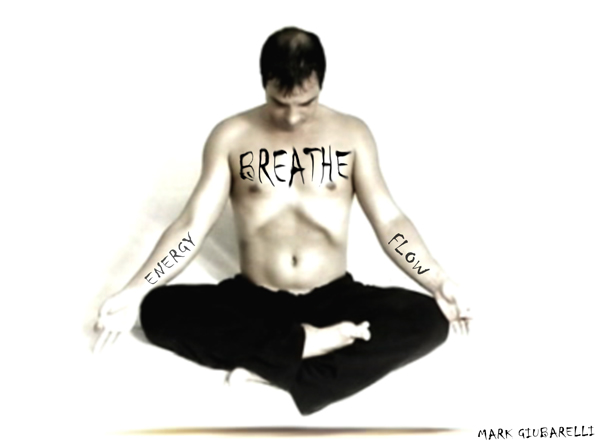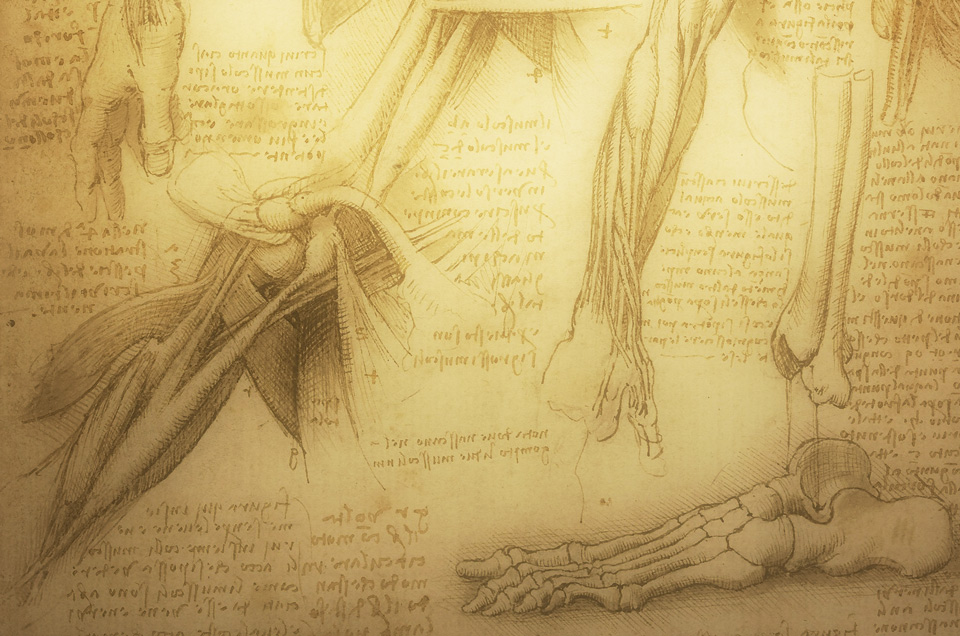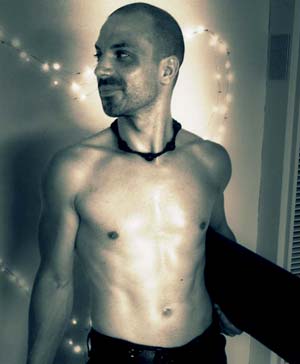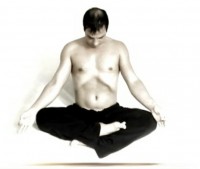Learn yoga anatomy to help understand the human body and the relationship with yoga asana. It should serve anyone wanting to know the basics of anatomy.
The number of muscles in our body varies from 640 to 850 skeletal, visceral, and cardiac muscles. Some are voluntary others involuntary. Yoga is the art of gaining control over the involuntary in an effort to master the body.
Written and compiled by Mark Giubarelli.
Muscles That Act On The Neck and Head
The human head is quite heavy with the average adult head weighs around 10 to 11 pounds (4.5 to 5 kg). This weight increases proportionally getting heavier the more the head leans forward and down. When upper posture is bad for every inch that the head moves forward in posture there is an increases the weight of the head on the neck of about 10 pounds (4.5 kg).
An average bowling ball weighs 16 pounds (7.2 kg) or less.
Posterior Muscles
Splenius Capitis – (Extends the head and cervical spine, Lateral flexion of the head and cervical spine)
Splenius Cervicis – (Extends head and neck. Laterally flexes head and neck to same side)
Semispinalis Capitis – (Extends and hyperextends the head and the neck. Uniterally rotates the head and the neck)
Semispinalis Cervicis – (Extension of the cervical spine, lateral flexion of the neck and rotation)
Semispinalis Thoracis – (Extends cervical neck and thoracic back vertebrae)
Rectus Capitis Posterior Major – (Extends and rotates atlanto-occipital joint)
Rectus Capitis Posterior Minor – (Extends and rotates atlanto-occipital joint)
Obliquus Capitis Superior – (Lateral flexes C1 atlanto-occipital joint)
Obliquus Capitis Inferior – (Rotates C2 atlanto-axial joint)
Anterior Muscles
Sternocleidomastoid – (Extends & rotates head, flexes vertebral column)
Scalenes
Neck Disorders
Cervical Disc Protrusion
Forward Head Posture FHP
What is the difference between a bulging disc and a herniated disc?
Neck Muscles Groups
![]()
Back Muscles
Multifidus - (Extends spine)
Rotators - (Rotates spine)
Levator Costarum (Elevates ribs)
Quadratus lumborum - (Lateral Flexion) (Lower Spine Rotation)
Erector spinae muscles explained
Erector spinae - spinalis - (Lateral flexion of spine)
Erector spinae - iliocostalis - (Extends and laterally flexes spine)
Erector spinae - longissimus - (Extends spine)
Longissimus Cervicis - Extends and hyperextends the neck vertebrae. Unilateral actions: laterally flexes the neck vertebrae to the same side.
Longissimus Thoracis - (Extension, lateral flexion of vertebral column, rib rotation)
Longissimus Lumborum - (Extends & rotates vertebral column)
Iliocostalis Lumborum - (Extension, lateral flexion of vertebral column, rib rotation)
Iliocostalis Thoracis - (Extension, lateral flexion of vertebral column, rib rotation)
Iliocostalis Cervicis - (Extends cervical vertebrae)
Sacrum Assessment in Relationship to muscle balance.
Anterior Muscles That Act On Shoulder
Serratus Anterior – (Protracts and stabilizes scapula, assists in upward rotation)
Serratus Posterior Superior – (Used for Breathing – Inhalation)
Serratus Posterior Inferior – (Used for Breathing – Exhalation)
Pectoralis Minor – (Draws the scapula round the ribs forward toward the ribs and lifts the ribs during inhalation)
Pectoralis Major (Adduction, flexion and medial rotation of arms)
Posterior Muscles That Act On Shoulder
Levator Scapulae – (Raises medial border of scapula)
Trapezius – (Elevation, depression and retraction of the scapula)
Rhomboid Major – (Retraction and depression of the scapula. Binds the scapula to the thoracic wall)
Rhomboid Minor – (Retraction and depression of the scapula. Binds the scapula to the thoracic wall)
Muscle That Act On The Arm
Deltoid - (Abduction, extension, lateral rotation, flexion and medial rotation of arm)
Pectoralis major - (Adduction, flexion and medial rotation of arm)
Biceps brachii - (Supinates forearm, flexes elbow, mildly flexes shoulder)
Coracobrachialis - (Flexes the arm, mildy adducts arm)
Subscapularis - (Medially rotates arm and stabilizes shoulder joint)
Teres major - (Medially rotates and adducts arm. Stabilizes shoulder joint)
Latissimus dorsi - (Adduction, extension and medial rotation of the arm. Retraction and depression of shoulder)
Supraspinatus - (Abducts arm and stabilizes shoulder joint)
Infraspinatus - (Laterally rotates arm and stabilizes shoulder joint)
Teres minor - (Laterally rotates arm and stabilizes shoulder joint)
Triceps brachii: long head - (Arm extension at the elbow)
Muscles That Act On The Abdomen
Internal oblique – (Compression of abdomen, flexion of vertebral column and rotation of vertebral column)
Rectus abdominis – (Flexion of the vertebral column, posteriorly tilts the pelvis, compresses abdominal contents, assists with exhalation)
![]()
Leg Muscles
Anterior
Iliacus – (Hip Flexion)
Psoas major – (Hip Flexion)
Tensor fasciae latae – (Internal rotation)
Sartorius – (Hip Flexion) (Hip abduction)
Rectus femoris – (Hip Flexion)
Pectineus – (Hip Adductor)
Adductor longus – (Hip Adductor)
Adductor brevis – (Hip Adductor)
Adductor magnus – (Hip Adductor)
Gracilis – (Hip Adductor)
Vastus lateralis – (Knee extension)
Vastus medialis – (Knee extension)
Vastus intermedius – (Knee extension)
Posterior
Gluteul Region – (Cadaver video)
Gluteus maximus – (External Rotation) (Leg Extension)
Gluteus medius – (Hip abductor) (Internal rotation)
Gluteus minimus – (Internal rotation) (Hip abductor)
Gemellus muscle – (External Rotation) (Leg Extension) (Adducts)
Obturator externus – (External Rotation) (Adductor when the hip in flexion)
Piriformis – (External Rotation)
Quadratus femoris – (External Rotation)
Obturator externus – (Hip Adductor)
Obturator internus – (External Rotation)
Superior gemellus – (External Rotation)
Inferior gemellus – (External Rotation)
Biceps femoris – long head – (knee flexion, internal and external rotation, and hip extension)
Biceps femoris – short head – (knee flexion, internal and external rotation, and hip extension)
Semimembranosus – (Extension of hip and flexion of knee)
Semitendinosus – (Extension of the thigh at the hip, Flexion of the leg at the knee, Internal rotation of the leg at the knee)
Gastrocnemius – (Plantar flexing the foot at the ankle joint, flexing the leg at the knee joint)
Soleus – Needs Edited
Plantaris – (Plantar flexes foot and flexes knee)
Foot Muscles
Plantaris - Needs Edited

Muscles Involved in Inhalation
Sternocleidomastoid, the scalenus anterior, medius, and posterior, the pectoralis major and pectoralis minor, the inferior fibres of serratus anterior and latissimus dorsi, the serratus posterior iliocostalis cervicis
Muscles Involved in Exhalation
Rectus abdominis, transverse abdominis, external oblique muscle and internal oblique muscle
Latest Posts On Yoga Anatomy
- Donate and Help Al Pardo
- Yoga Body Mechanics Study
- The Cost Of Clean Air
- Guru forcing himself on a student gets his private parts chopped off!
- Terrible Effects of Mobile Phones On Posture
- Example Of Scarred Tissue under the shoulder
- What does USP Grade mean?
- Yoga Studios Closing at Alarming Rates in Los Angeles
- Iodine has the power to prevent breast cancer

Movements Of The Body
Flexion: The angle between two bones decreases - bending.
Extension: The angle between two bones increases - straightening.
Horizontal flexion: The angle between two bones decreases on the horizontal plane.
Horizontal extension: The angle between two bones increases on the horizontal plane.
Lateral Flexion: Away from the midline of the body.
Abduction: Away from the midline of the body.
Adduction: Toward the midline of the body.
Circumduction: This is a movement where the joint is the pivot and the body segment moves in a combination of flexion, extension, adduction and abduction.
Protraction: Increasing space between the shoulders.
Retraction: Scapula pulling together decreasing space between the shoulders.
Elevation: Scapula raising up.
Depression: Scapula moving downwards.
Rotation: Twisting turning movement. Medial and lateral rotation.
Medial rotation: Rotates inwards towards the midline .
Lateral rotation: Rotates outwards away from the midline of the body.
Hand Supination: Hands palm turned facing upward or forward anteriorly.
Foot Supination: – combination of inversion, plantar flexion and adduction of the foot.
Hand Pronation: The palm of the hand faces downward or backward posteriorly.
Foot Pronation: – combination of eversion, dorsiflexion and abduction of the foot.
Plantar flexion: Is moving the top of the foot away from the shin or ‘pointing’ the toes.
Dorsiflexion: Is moving the top of the foot toward the shin or ‘raising’ the toes.
Spine (Cervical)
Flexion
Extension / Hyperextension
Lateral Flexion (Abduction)
Reduction (Adduction)
Rotation
Spine (Thoracic, Lumbar)
Flexion
Extension / Hyperextension
Lateral Flexion (Abduction)
Reduction (Adduction)
Rotation
Scapula & Clavicle
Abduction (Protraction)
Adduction (Retraction)
Depression
Elevation
Rotation Upward (Superior Rotation)
Rotation Downward (Inferior Rotation)
Shoulder (Glenohumeral)
Adduction
AbductionFlexion
Extension / Hyperextension
Transverse Adduction
Transverse Flexion
Transverse Abduction
Transverse Extension
Medial Rotation (Internal Rotation)
Lateral Rotation (External Rotation)
Elbow Flexion - Bending Arm
- Prime Mover: Brachialis , Biceps brachii, Brachioradialis
Elbow Extension - Straighten arm at elbow
- Prime Mover: Triceps brachii
Forearm (Radioulnar)
Pronation
Supination
Hip Extension - Straighten across hip
- Prime Mover: Gluteus maximus
- Synergists: Biceps femoris , semitendinosus, semimembranosus, posterior head of adductor magnus
- Antagonists: Psoas, iliacus, tensor fascia latae, rectus femoris, pectineus, sartorius
Hip Flexion - Bend at Hip
- Prime Mover: Psoas
- Synergists: Iliacus, tensor fascia latae, rectus femoris, anterior adductors (especially pectineus), sartorius
- Antagonists: Gluteus maximus, biceps femoris (long head), semitendinosus, semimembranosus, posterior head of adductor magnus
Hip Internal Rotation
- Prime Mover: Gluteus minimus
- Synergists: Gluteus medius, tensor fascia latae, semitendinosus, semimembranosus, anterior adductors
- Antagonists – Gluteus maximus, posterior fibers of gluteus medius, biceps femoris (long head), posterior head of adductor magnus, deep six rotators, sartorius
Hip External Rotation
- Prime Mover: Piriformis
- Synergists: Deep six rotators of hip, gluteus maximus, posterior fibers of gluteus medius, biceps femoris (long head), posterior head of adductor magnus, sartorius
- Antagonists: Anterior fibers of gluteus medius, gluteus minimus, tensor fascia latae, semitendinosus, semimembranosus.
Hip Abduction
- Prime Mover: Gluteus medius
- Synergists: Gluteus maximus, gluteus minimus, tensor fascia latae, sartorius, vastus lateralis
- Antagonists: Adductor magnus, pectineus, adductor brevis,
Knee Flexion:
- Prime Mover: Biceps femoris, semimembranosus, semitendinosus.
- Synergists: popliteus, gastrocnemius, gracilis, sartorius.
- Antagonists: vastus lateralis, vastus medialis, vastus intermedius, rectus femoris.
Knee Extensors:
- Prime Mover: vastus lateralis, vastus medialis, vastus intermedius, rectus femoris.
- Synergists: Not applicable.
- Antagonists: Biceps femoris, semimembranosus, semitendinosus, popliteus, gastrocnemius, gracilis, sartorius.
Ankle
Plantar Flexion
Dorsi Flexion



